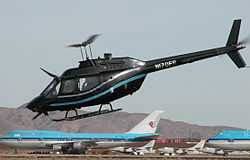Wire strike protection system
| Wire Strike Protection System | |
|---|---|
 A Bell 206 shows cutters above and below cockpit section of WSPS. |
The wire strike protection system (WSPS) (Developed for the OH-58 / Bell 206 in 1979) is an entire system of components designed to mitigate the risk of wire strikes while flying helicopters at Nap-of-the-earth altitudes, as well as takeoffs and landings.
The system is mounted around the front of many U.S Marine Corps, U.S Navy, U.S Air Force, U.S Army,[1] and some civilian helicopters. The larger CH-46 and CH-47 tandem rotor helicopters have no WSPS systems installed.
The WSPS system generally appears as two guidance swords at the upper and lower front of the cabin protruding forward 45° above and below the horizontal. In each of the inner corners to the cabin a fixed, massive pair of scissors made of hardened steel is mounted, whose opening angle is so small, that a speedy or forced incoming steel cable is cut through.
(These swords are often mistaken for radio antennas). The entire system may include upper and lower cutter assemblies, a non-electrically conductive abrasive strip wire scoring device along the center of the divided windscreen, and windshield wiper protector frames to keep wires from hanging up on wiper motor shafts. [2] The WSPS is designed to channel a wire or cable into the cable cutter, score and weaken it as it travels into the cutter assembly, and "cut" a wire before it can entangle the rotor system or cause a crash. The U.S. Army Safety Center at Fort Rucker, AL, claims that in a single wire strike, 90% survivability is achieved by using WSPS. The more wires you encounter at a given time, the less likely WSPS will help you survive the encounter.
Some WSPS lower cutters have a break away tip in case of nose low ground impact.
References
External links
- www.helicopterpage.com - WSPS system (How Helicopters Work)
- Safety Study of Wire Strike Devices Installed on Civil and Military Helicopters
- Wire Strike Accidents in General Aviation: Data Analysis 1994 to 2004 – Page 33
- Wire Strike Protection System, MDHS 500 Maintenance Manual
- Magellan Aerospace Announces New Bell Helicopter Wire Strike Protection System Development
| |||||||||||||||||||||||||||||||||||||
